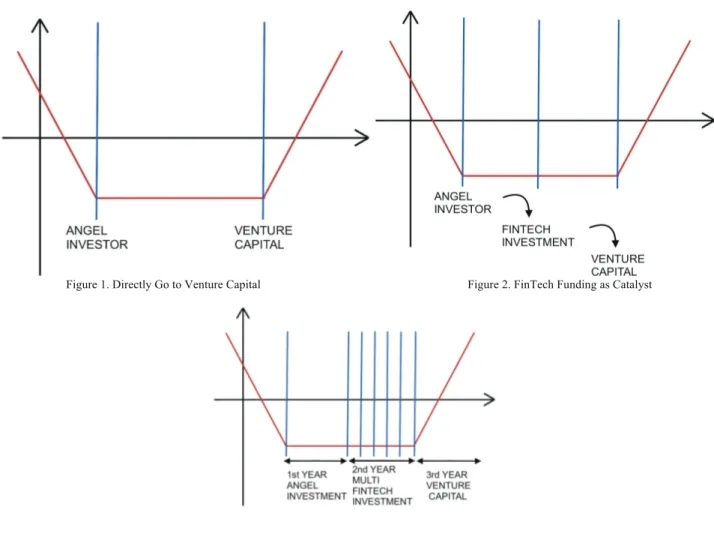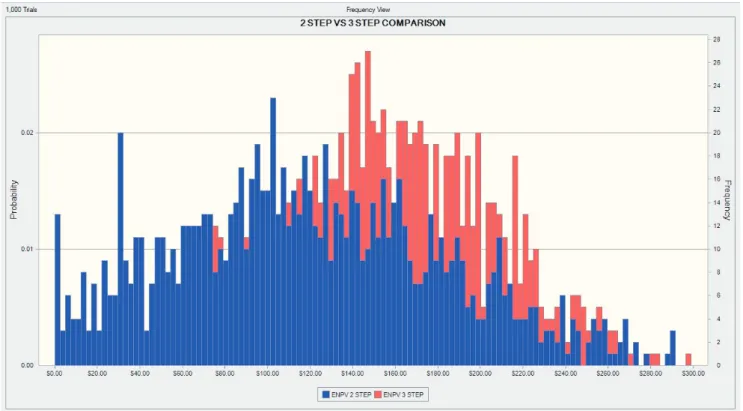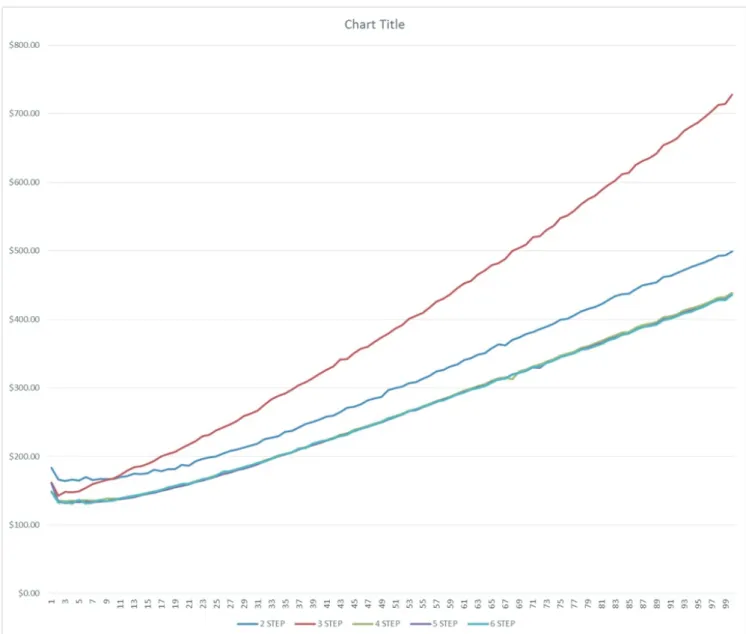JAIST Repository
https://dspace.jaist.ac.jp/
Title
Study on Survival of Supply Chain Startups in Indonesia using FinTech : Based on Real Options Analysis
Author(s) Wibowo, Fistyan Ikhsan; Fujiwara, Takao
Citation 年次学術大会講演要旨集, 31: 492-495
Issue Date 2016-11-05
Type Conference Paper
Text version publisher
URL http://hdl.handle.net/10119/13991
Rights
本著作物は研究・イノベーション学会の許可のもとに 掲載するものです。This material is posted here with permission of the Japan Society for Research Policy and Innovation Management.
2 E 1 9
Study on Survival of Supply Chain Startups in Indonesia using FinTech: Based on
Real Options Analysis
○Fistyan Ikhsan Wibowo(Toyohashi University of Technology) Takao Fujiwara(Toyohashi University of Technology)
1. Introduction
Fintech as Funding for Startup In Indonesia
Startups in Indonesia are a relatively easier to get raising their first round of funds as investors are eager to pour in money. Especially there are angel investors who understand your ability and are interested in your idea.
But it is at the next level of funding, critical to achieve scale, where many promising startups have failed to appeal their product to investors. Even attractive investment themes such as food delivery, apparel and hyper-local logistics services too saw some startups succumb to more competitive condition as they could not get needed growth capital.
Some people assume that receiving seed money is easy, but actually even seed period will get harder if you don’t have good name on staff nor track record. Usually in Indonesia, investors who invest in seed period, believe that the current team inside the startups capable to generate return and become bigger. But what if the startups don’t have a big name and less credible team? How can they get funding?
Small startups have always had a harder time securing funding, but these challenges have grown even worse in recent years. As economic conditions have improved recently, several startups have been seeking additional capital to invest and expand. Perhaps the biggest area of upheaval has been in the way people and organizations lend and borrow money. Traditionally, banks had the monopoly on this.
But recently several startups have found a way to squeeze these margins and offer a better deal to savers and, often borrowers, by using “peer-to-peer”. These changes have been driven not by established financial players, but by startups including known huge players like LendingClub, Kickstarter, and Funding Circle.
Venture capital also will not invest the money into unknown and un-credible small startup. Hence, by breaking this investment period into more several steps, even small funding, it can help the startup to continue.
FinTech not just funding, it’s also the signaling of the potential of start-ups under asymmetric information. If startup performs well after receiving the funding from FinTech, it increases their name value also easier to receive venture capital in the future.
2. Real Options as Methodology
Flexibility of Sequential Compound Real Options
Sequential Compound Options are applicable for research and development investments or any other investments that have multiple stages. The easiest way to understand this option is to start with a two-phased Sequential Compound Option as seen in Figure 1. Management has the ability to decide if Venture Capital Phase should be implemented after obtaining the results from Angel Investment Phase (Reid, 1998). For example, selling of new products in Angel Investment Phase indicates that the products are not good enough for the market, hence Venture Capital Phase can be reluctant to start investing. All that is lost is only the Angel Investment Phase as sunk cost, not the entire investment cost of both Angel Investment Phase and Venture Capital Phase except opportunity cost of failure of the promising but risky start-ups.
This model provides the decision maker with a view into the optimal balancing between waiting for more information (Expected Value of Perfect Information) and the cost of waiting. You can analyze this balance by creating strategic options to defer investments through development stages where at every stage the project is reevaluated as to whether it is beneficial to proceed to the next phase. Based on the input assumptions used in this model, the Sequential Compound Option results show the strategic value of the project, and the NPV is simply the PV Asset less both phases’ Implementation Costs. In other words, the strategic option value is the difference between the calculated strategic value minus the NPV. It is recommended for your consideration that the volatility and dividend inputs are varied to determine their interactions
2 E 1 9
Study on Survival of Supply Chain Startups in Indonesia using FinTech: Based on
Real Options Analysis
○Fistyan Ikhsan Wibowo(Toyohashi University of Technology) Takao Fujiwara(Toyohashi University of Technology)
1. Introduction
Fintech as Funding for Startup In Indonesia
Startups in Indonesia are a relatively easier to get raising their first round of funds as investors are eager to pour in money. Especially there are angel investors who understand your ability and are interested in your idea.
But it is at the next level of funding, critical to achieve scale, where many promising startups have failed to appeal their product to investors. Even attractive investment themes such as food delivery, apparel and hyper-local logistics services too saw some startups succumb to more competitive condition as they could not get needed growth capital.
Some people assume that receiving seed money is easy, but actually even seed period will get harder if you don’t have good name on staff nor track record. Usually in Indonesia, investors who invest in seed period, believe that the current team inside the startups capable to generate return and become bigger. But what if the startups don’t have a big name and less credible team? How can they get funding?
Small startups have always had a harder time securing funding, but these challenges have grown even worse in recent years. As economic conditions have improved recently, several startups have been seeking additional capital to invest and expand. Perhaps the biggest area of upheaval has been in the way people and organizations lend and borrow money. Traditionally, banks had the monopoly on this.
But recently several startups have found a way to squeeze these margins and offer a better deal to savers and, often borrowers, by using “peer-to-peer”. These changes have been driven not by established financial players, but by startups including known huge players like LendingClub, Kickstarter, and Funding Circle.
Venture capital also will not invest the money into unknown and un-credible small startup. Hence, by breaking this investment period into more several steps, even small funding, it can help the startup to continue.
FinTech not just funding, it’s also the signaling of the potential of start-ups under asymmetric information. If startup performs well after receiving the funding from FinTech, it increases their name value also easier to receive venture capital in the future.
2. Real Options as Methodology
Flexibility of Sequential Compound Real Options
Sequential Compound Options are applicable for research and development investments or any other investments that have multiple stages. The easiest way to understand this option is to start with a two-phased Sequential Compound Option as seen in Figure 1. Management has the ability to decide if Venture Capital Phase should be implemented after obtaining the results from Angel Investment Phase (Reid, 1998). For example, selling of new products in Angel Investment Phase indicates that the products are not good enough for the market, hence Venture Capital Phase can be reluctant to start investing. All that is lost is only the Angel Investment Phase as sunk cost, not the entire investment cost of both Angel Investment Phase and Venture Capital Phase except opportunity cost of failure of the promising but risky start-ups.
This model provides the decision maker with a view into the optimal balancing between waiting for more information (Expected Value of Perfect Information) and the cost of waiting. You can analyze this balance by creating strategic options to defer investments through development stages where at every stage the project is reevaluated as to whether it is beneficial to proceed to the next phase. Based on the input assumptions used in this model, the Sequential Compound Option results show the strategic value of the project, and the NPV is simply the PV Asset less both phases’ Implementation Costs. In other words, the strategic option value is the difference between the calculated strategic value minus the NPV. It is recommended for your consideration that the volatility and dividend inputs are varied to determine their interactions
Figure 1. Directly Go to Venture Capital Figure 2. FinTech Funding as Catalyst
Figure 3. Multi Stage on FinTech Funding 3. Study Design
Venture Capital would be good founding for any startups. But for startups which don’t have a big name and less credible team, it will be really difficult to get funds from them. The objective of this research is, using peer-to-peer lending of FinTech like LendingClub, we expect to extend the life of startup and also make Venture Capital to notice them. (Figure 2)
Using Oracle Crystal Ball Software to calculate the binomial lattice and expected NPV from the 5 scenarios in Table 1 and the parameter of calculation on Table 2 (Copeland & Antikarov, 2003; Mun, 2003).
Table 2. Parameter use for Research
4. Analysis Result
The red bars are Monte Carlo Simulation on 3 steps Compounding Option and blue bars are Monte Carlo Simulation on 2 steps compounding option in Figure 4. Even with same amount of asset and investment implementation cost, by breaking the funding into several steps, it can help startup to continue their business.
But this breaking the funding in several steps in FinTech not always ended with better result. If we try to break the FinTech founding period into more than 2 like Figure 3. The result can be like in Table 2. When volatility getting bigger, the expected net present value of 3 Step Sequential Compound Option is getting further from 2 Step Sequential Compound Option. But for 4 Step to 6 Step Sequential Compound Option, the result is worse than 2 Step Sequential Compound Option as shown in Figure 5.
The main reason why Multi Steps for FinTech resulting worse than 2 Step and 3 Step Sequential Compound Option is because they may not have any space to be failed at all. By breaking into smaller step, the investment risks become lower, but at same time it can reduce the possibility to bounce back once they failed. at early time. In the other hand for 3 Steps Sequential Compound Option, it has plenty of time to bounce back as long as they not reach minus.
Figure 4. Comparison Between 3 Step vs. 2 Step Sequential Compound Option with 15% Volatility. The red bar (3 Step Sequential Compound Option) located more right hand side shown that the ENPV is higher, and the height of the bar also higher shown that the probability to reach certain
Table 2. Parameter use for Research
4. Analysis Result
The red bars are Monte Carlo Simulation on 3 steps Compounding Option and blue bars are Monte Carlo Simulation on 2 steps compounding option in Figure 4. Even with same amount of asset and investment implementation cost, by breaking the funding into several steps, it can help startup to continue their business.
But this breaking the funding in several steps in FinTech not always ended with better result. If we try to break the FinTech founding period into more than 2 like Figure 3. The result can be like in Table 2. When volatility getting bigger, the expected net present value of 3 Step Sequential Compound Option is getting further from 2 Step Sequential Compound Option. But for 4 Step to 6 Step Sequential Compound Option, the result is worse than 2 Step Sequential Compound Option as shown in Figure 5.
The main reason why Multi Steps for FinTech resulting worse than 2 Step and 3 Step Sequential Compound Option is because they may not have any space to be failed at all. By breaking into smaller step, the investment risks become lower, but at same time it can reduce the possibility to bounce back once they failed. at early time. In the other hand for 3 Steps Sequential Compound Option, it has plenty of time to bounce back as long as they not reach minus.
Figure 4. Comparison Between 3 Step vs. 2 Step Sequential Compound Option with 15% Volatility. The red bar (3 Step Sequential Compound Option) located more right hand side shown that the ENPV is higher, and the height of the bar also higher shown that the probability to reach certain
ENPV also higher compare to 2 Step Sequential Compound Option.
Figure 5. Multi Stages of FinTech Founding and Volatility. Number on X-axis indicates percentages of volatility and number on Y-axis indicates amount of ENPV. The width between 3 Steps and 2 Step Sequential Compound Option becomes bigger when Volatility percentages increase. 5. Conclusion and Future Direction
This approach is possibly able to save several startups that hard to get funding by FinTech, then to continue their business and get some attention from Venture Capital. The basic result is still under assumption of no rival and competition in same industry. The length of survival, expand factor, dividend, and rival were still not considered.
For the future direction, we plan to use several additional parameters for consideration and also Bayesian Data Analysis for calculating movement of Venture Capital according to startup performance on FinTech Investment Phase.
References
Copeland, T., & Antikarov, V. (2003). Real Options: A practitioners guide. New York: Texere LLC.
Mun, J. (2003). Real options analysis course: Business cases and software applications. Hoboken, NJ: Wiley. Reid, Gavin C. (1998). Venture Capital Investment, An agency analysis of practice. London, Routledge


